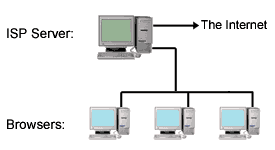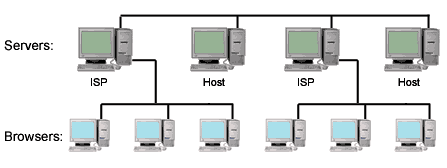Servers are where most of the information on the internet "lives". These are specialised computers which store information, share information with other servers, and make this information available to the general public.
Browsers are what people use to access the World Wide Web from any standard computer. Chances are, the browser you're using to view this page is either Netscape Navigator/Communicator or Microsoft Internet Explorer. These are by far the most popular browsers, but there are also a number of others in common use.
When you connect your computer to the internet, you are connecting to a special type of server which is provided and operated by your Internet Service Provider (ISP). The job of this "ISP Server" is to provide the link between your browser and the rest of the internet. A single ISP server handles the internet connections of many individual browsers - there may be thousands of other people connected to the same server that you are connected to right now.
The following picture shows a small "slice" of the internet with several home computers connected to a server:

Host servers are where websites "live". Every website in the world is located on a host server somewhere (for example, MediaCollege.Com is hosted on a server in Parsippany, New Jersy USA). The host server's job is to store information and make it available to other servers.
The picture below show a slightly larger slice of the internet:

- You either type an address (URL) into your "Address Bar" or click on a hyperlink.
- Your browser sends a request to your ISP server asking for the page.
- Your ISP server looks in a huge database of internet addresses and finds the exact host server which houses the website in question, then sends that host server a request for the page.
- The host server sends the requested page to your ISP server.
- Your ISP sends the page to your browser and you see it displayed on your screen.



0 comments:
Post a Comment